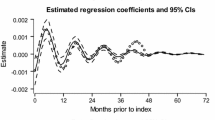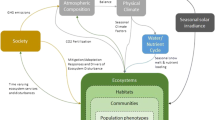Abstract
A new approach for the analysis of empirical phenological data is presented which supports oligofactorial seasonality modelling. The temporal resolution of this approach is only limited by the temporal aggregation or sampling frequency (1 day, typically, in the case of weather elements) of the available primary data on the relevant environmental factors. The phenological periods of interest may be “phenologically opaque” in the sense that they do not contain any phenologically observable events except their onset and end. In traditional approaches, the available primary data are aggregated over the duration of the respective phenological period (weeks or even months, typically, in plant phenology). The new approach is supported by modern mathematical methods, which allow for data analysis under unfavourable conditions of irregular oligofactorial data design, and could thus also upgrade traditional approaches of phenological data analysis.
Similar content being viewed by others
References
Bard Y (1973) Nonlinear parameter estimation. Academic Press, New York
Deutscher Wetterdienst (1971–1990). Deutsche Meteorologische Jahrbücher 1969–1988. Deutscher Wetterdienst, Offenbach
Duchon J (1977) Splines minimizing rotation-invariant seminorms in Sobolev spaces. In: Schempp W, Zeller K (eds) Constructive theory of functions of several variables (Lecture Notes in Mathematics, vol 571). Springer, Berlin, pp 85–100
Franke R (1982) Scattered data interpolation: tests of some methods. Math Comp 38:181–200
Freitag E (1965) Studien zur phänologischen Agrarklimatologie Europas. Berichte des Deutschen Wetterdienstes, Nr. 98 (Band 14). Deutscher Wetterdienst, Offenbach
Golub GH, Van Loan CF (1983) Matrix computations, Johns Hopkins University Press, Baltimore
Gordon WJ, Wixom JA (1978) Shepard's method of “metric interpolation” to bivariate and multivariate data. Math Comp 32:253–264
Hansen PC (1992) Analysis of discrete ill-posed problems by means of the L-curve. SIAM Rev 34:561–580
Hodges T, French V (1985) Soyphen: soybean growth stages modeled from temperature, daylength, and water availability. Agron J 77:500–505
King AW, de Angelis DL (1985) Information for seasonal models of carbon fluxes in terrestrial biomes. Publication no. 2485, Environmental Sciences Division, Oak Ridge National Laboratory, pp 1–40
Klein G, Berlekamp J (1986) Glatte empirische Modellierung mehrfaktorieller Systemresponse. Landschaftsökol Mess Ausw 2:11–31
Klein GH (1987a) Fitting simple non-tensor-product splines to scattered noisy data on Euclidean d-space. J Comp Appl Math 18:347–352
Klein GH (1987b) Handy splines for empirical oligofactorial modelling of systems responses. Envir Softw 2:26–28
Klein GH (1987c) Smooth descriptive modelling of multifactorial systems responses. In: Möller DPF (ed) System analysis of biological processes. Vieweg, Braunschweig — Wiesbaden, pp 95–100
Klein GH (1993) Modern mathematical methods for empirical multifactorial modelling. (manuscript in preparation)
Lieth H, ed (1974) Phenology and seasonality modelling (Ecological Studies, vol 8). Springer, Berlin New York
Press WH, Flannery BP, Teukolsky SA, Vetterling WT (1988) Numerical recipes in C: the art of scientific programming. Cambridge University Press, Cambridge New York Melbourne
Schnelle F (1955) Pflanzen-Phänologie. Geest and Portig, Leipzig
Schnelle F, Baumgartner A, Freitag E (1985) 25 years of phenogical observations in the International Phenological Gardens. Arboreta Phaen 29:1–44
Wang JY (1967) Agricultural meteorology. Agriculture Weather Information Service, San José, pp 261–333
Author information
Authors and Affiliations
Rights and permissions
About this article
Cite this article
Klein, G.H. Time-resolved empirical modelling of seasonal development during phenologically opaque periods. Int J Biometeorol 38, 70–77 (1995). https://doi.org/10.1007/BF01270662
Received:
Revised:
Accepted:
Issue Date:
DOI: https://doi.org/10.1007/BF01270662




